





PHOTO GALLERY

Photos taken in Mexico
1. Broad-billed Hummingbird
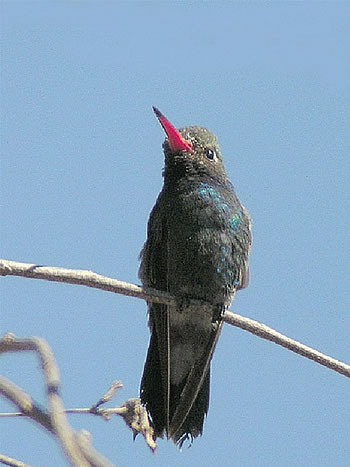
We took a day trip out of Mazatlan before our scheduled tour with Mark Pretti. East of the city we walked up a dirt road and found this Broad-billed Hummingbird (Cynanthus latirostris) perched for a rest. The angle of view showed off the broad-based bill well. Just a hint of the blue throat (gorget) seen here. This species seen in our southwest (Arizona, New Mexico, Texas) but range does not extend beyond southern Mexico. Prefers arid habitat. Species not well-studied to date.
Hummingbirds are found only in the New World, luckily for us.
Order: Apodiformes - Swifts and Hummingbirds (both have short legs!)
Family: Trochilidae - Hummingbirds. 338 species in 100+ genera. 18 species seen in
U.S. (try Southeast Arizona), but most people see just Anna's or Ruby-throated hummers.
In Mexico there are about 65 species, and even greater numbers in Ecuador, etc.
Genus: Cynanthus - Translates as "flower dog". Guess because the hummers hound a
flower the way a dog worries a bone. Three species in Cynanthus, including Dusky HB and
Doubleday's HB.
Species: Cynanthus longirsotris. You probably guessed that longirostris translates to "broad-billed".
2. Broad-billed Hummingbird on nest
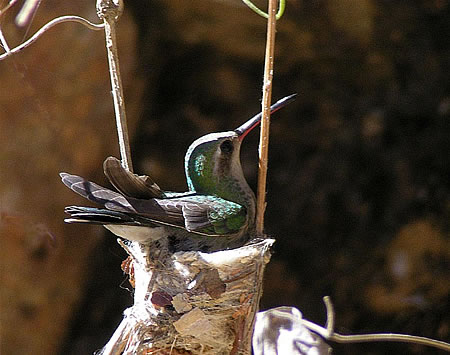
(Apologies to those who feel that nesting birds should not be photographed. Rest assured that this photo was taken from a distance of 20'.)
As we walked along Panuco Road, Karen spotted a hummingbird on a nest, not two feet from the roadway. It was a female Broad-billed Hummingbird, who strangely had chosen this busy and unprotected site for nesting. Harsh lighting limits picture quality, but hey, I take what I can get.
The male hummer takes no part in parenting. He establishes a territory near a good patch of flowers, hoping to attract a visiting female. After a suitable display by the male they mate, and she flies back to her territory, where in due time she lays the eggs (often two) in a carefully constructed and beautifully camouflaged thimble of nothingness. She does all the brooding and parenting, taking brief respites to forage provide for the nutrition of self and the brood. She will vigorously defend her nest area against any intruders.
3. Russet-crowned Motmot
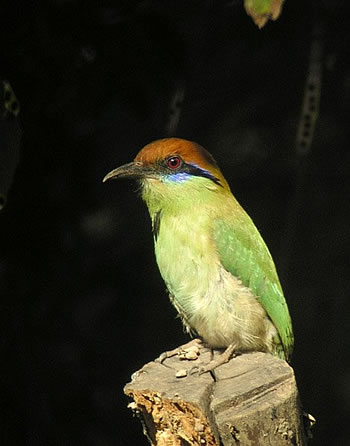
Just outside of San Blas our group headed down Singayta Road. Our leader Mark Pretti spotted a special bird, and the excitement level bumped up about 4 notches. A Russet-crowned Motmot sallied out for a fly and returned to a stump along the roadside, where it posed nicely for 5 minutes. Special bird, perfect light. It doesn't get any better.
They nest in a long tunnel carved into a bank, like Kingfishers. Diet includes insects and other small creatures.
Order: Coraciformes (Quite a colorful group, with Kingfishers, Todies, Bee-eaters, Rollers,
Hornbills and of course the Motmots)
Family: Momotidae - The Motmots. These are New World tropical species, in several
genera. About 10 species in all, but the lumping and splitting is too complicated for me.
Species: Momotus mexicanus - The Russet-crowned Motmot. Closely related to the
Blue-crowned Motmot, Momotus momota, and perhaps a subspecies in some references.
Other Motmots, beside the Blue-crowned, include Rufous, Rufous-capped, Broad-billed,
Highland (Carribean), Tody, Turquoise-browed (Costa Rica!!), Blue-throated and Keel-billed.
4. Groove-billed Ani
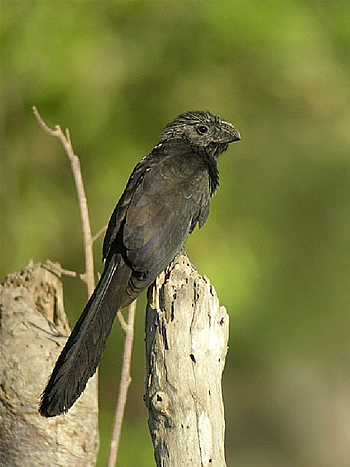
The Cuckoo family (Cuculidae), includes the Cuckoos, Anis, and Roadrunners. The Groove-billed Ani (Crotophaga sulcirostris) is regularly seen in south Texas, and has been sighted as a vagrant in many other states. South of the border it is a common bird in the lowlands of Mexico, and ranges down to Chile and Northern Argentina.
You'd might think that the massive bill is a perfect took for cracking open nuts and hard fruits. Well, at least that was my thought. But Crotophaga means "insect eater", and that is largely what the Ani eats. I first "met" the Ani in high school, when I started to do crossword puzzles. Sulcirostris translates as"groove-billed". Finally a bird whose scientific name really makes sense! Note the long tail, another feature of our cuckoos.
The other Anis are the Smooth-billed Ani (C. ani) and the Greater Ani (C. major).
6. Streak-backed Oriole
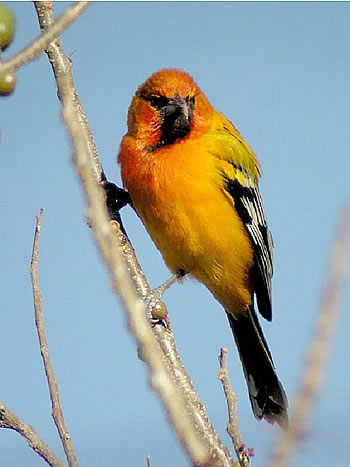
We saw seven Oriole species on our recent west Mexico trip, and this handsome adult male Streak-backed Oriole (Icterus pustulatus) was the most common. This is largely a Pacific Slope species, Mexico to Honduras, but is occasionally seen in Southeast Arizona and southern California. Not the best photo for all the field marks (i.e., can't see the streaked back!!), but at least we can see the intense orange color, almost red on the crown, with a narrow black "bib" and fair amount of white in the wings. Previously known as the Scarlet-headed Oriole.
7. Blue-crowned Motmot
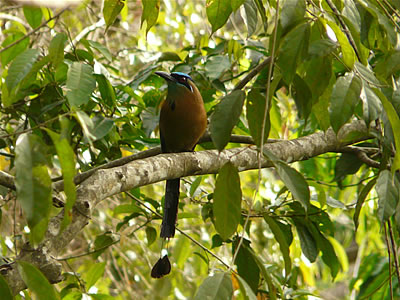
TOWHEE.NET: Harry Fuller, 820 NW 19th Street, McMinnville, OR 97128
website@towhee.net